|
|
|
|
| Home > Reviews > Russia > Tamiya 1/35 scale Military Miniatures Series Kit No. 35309; Russian Tank BT-7 Model 1935 |
Russian Tank BT-7 Model 1935
Reviewed by Cookie Sewell
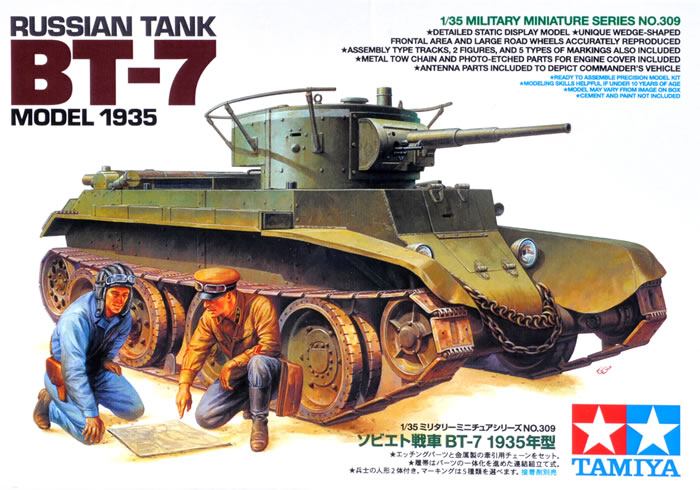
Summary
| Stock Number and Description | Tamiya 1/35 scale Military Miniatures Series Kit No. 35309; Russian Tank BT-7 Model 1935 |
| Scale: | 1/35 |
| Media and Contents: | 264 parts (213 in green styrene, 17 in grey styrene, 10 large vinyl keepers, 8 small vinyl keepers, 8 clear styrene, 7 etched nickel, 1 length of steel chain) |
| Price: | USD $62.00 |
| Review Type: | First Look |
| Advantages: | Nice, clean, easy-to-assemble kit of this vehicle; use of slide molding extensive and parts breakdown well engineered; figures a plus |
| Disadvantages: | Choice of early production model perhaps not what modelers were hoping for |
| Recommendation: | Recommended for all Soviet fans |
FirstLook
When eccentric American inventor J. Walter Christie sold his “Model 1940" wheel-and-track drive tank to a Soviet purchasing committee in 1930, it is doubtful that he would eventually see close to 100,000 vehicles built using that basic design and suspension over the next 16 years. While the British also bought the design and used it for a series of tanks ending with the Covenanter, Crusader and Cromwell, the Soviets put theirs into production first as the BT (for Bystryy Tank or Fast Tank) series of tanks and then the legendary T-34 series.
The first tank, the BT-2, was basically little more than the Christie design fitted with a Soviet-designed turret mounting a 37mm gun and a 7.62mm DT machine gun in separate mounts. Between 1932 and mid 1933 the Soviets built 620 of these tanks. Starting in mid 1933, they changed over to a new tank, the BT-5, which corrected a number of the problems with the BT-2 and also used a new turret similar to the single turret on the T-26 tanks. This was fitted with a 45mm antitank gun and DT machine gun in a coaxial mount, and also was fitted to mount an optional rear machine gun (rarely used with this tank and eventually dropped for a pistol port).
From 1933 to December 1934 the Soviets built 1,884 BT-5 series tanks (of which 243 were fitted with radios and the curious “handrail” antenna). But there were still problems with the tank, and as a result it received a major redesign that culminated with the BT-7 design that entered production in January 1935.
The BT-7 was wider, had a new bow section and a completely redesigned stern that used internal mufflers and also provided additional fuel stowage at the rear of the hull. It soon switched over to a common design “elliptical” turret which it shared with the T-26 tanks of the period. Over the five years of production the Soviets produced more than 5,5500 BT-7 series tanks of all types, with the final model being the BT-7M. This tank, virtually identical to the late BT-7 series tanks, was fitted with the naturally aspirated BD-2 diesel engine of 400 HP. This was later modified to become the famous V-2 diesel of 500 HP which was used throughout WWII and forms the basis for many Russian tank engines to the present day.
But like all Soviet tanks of the period, the tanks underwent “tweaks” and modifications as they progressed down the line. The most obvious change took place in mid 1937 when the T-26 type turret was replaced by a conical one with tapered sides offering slightly improved armor protection. In 1938 a new lighter short-pitch track was introduced along with a six-roller drive wheel for them when used (the earlier BT-5 type track used a four-roller drive wheel). This track was later retrofitted to BT-5 tanks as well, but when the war broke out not all tanks were overhauled and so equipped. The track was also accompanied by new drive wheels with wider tires (from 52mm wide tires with the BT-5 style track to 75mm) as well as new idler wheels (tires went from 38mm to 52mm); the road wheels were enlarged from 815 mm bto 830mm diameter with 102mm wide tires.
Note that all basic T-26 fittings - combat spotlights above the gun and the P-40 antiaircraft machine gun mount – were also fitted to select BT-7 tanks.
During production some changes were made which did not show (such as a new transmission casing) but others did, such as new guards for the tracked final drive units that were better armored and better protected from dust and mud. The BT-7M replaced the large air cleaner for the gasoline engine with a small one for the diesel (basically its one major external feature).
Production apparently went as follows: 1934, 2 prototypes; 1935 - 500; 1936 - 1,049; 1937 - approximately 314 with cylindrical turrets and 314 with conical turrets; 1938 - 1,102 tanks with new tracks and conical turrets; 1939 - 1,347 tanks; 1940 (BT-7M) - 779. They also produced 155 of the BT-7A model “artillery tanks” with T-26-4 model turrets mounting a 76.2mm howitzer and DT gun in separate mounts as well as a handful of prototypes culminating with the A-20 (“BT-20").
The only kits of the BT-7 in styrene in 1/35 scale up until this point were the Eastern Express kits from Russia, which – while they did a good job of replicating the BT-7 series tanks – were beastly builds with very nasty front wheels and other quirks. Tamiya recently surprised the modeling community with this kit of an early Model 1935 based on the vehicle at the Central Army Museum in Moscow.
Tamiya’s kit is shown by comparison with all references I have (which are plentiful for these vehicles now) to be a straight up Model 1935. It matches up with one of the first 1,860 tanks built in features and accuracy, and also can be built as either a “line” tank (BT-7) or “radio” tank (BT-7 radio, occasionally seen as BT-7RT). The kit is one of the most beautifully engineered kits I have seen in some time and also comes with Tamiya’s exemplary directions. (Some of its competitors should take note and not scrimp on their instructions.) In point of fact, the kit comes with assembly instructions, history, finishing directions, and a set of color photos of the Moscow vehicle as a package.
Tamiya appears to already have plans for other versions of the BT family as they have designed the kit in such a way that selected sprues can be replaced and used for both the more desirable BT-7 Model 1937 with the conical turret or also any of the BT-5 series tanks.
There are a goodly number of “in your face” engineering tricks used on this kit, which pleases me no end! (As a big Russian armor fan and having seen their mediocre T-72M1 and pedestrian IS-3 kits I did not hold out high hopes they would get this one right.) For example, the entire rail antenna with brackets is molded as a single piece, including the “pot” attachment to the turret roof. The rear radiator air exhaust louvers are molded in place with the slots for the exhaust pipes (hollowed out using slide molding) right in them.
For fitting the mandatory etched nickel grille over the air exhaust louvers, Tamiya provides a two-part “press” that automatically bends the grille to the right shape for installation.
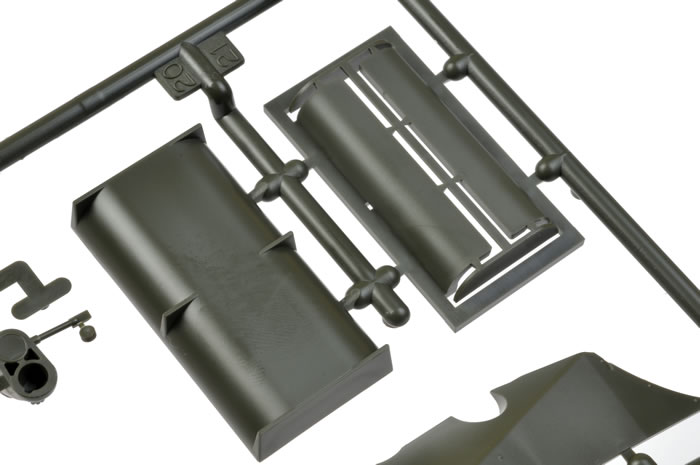
Suspension is conventional with the familar vinyl “keepers” on the wheels but it does come with the more common recent Tamiya use of “link and length” BT-5 style tracks (as the BT-5 style drivers come on this sprue it is likely that the BT-7 drivers and short-pitched tracks will come later on a different sprue). While the tracks will thus be fixed the use of the keepers means you can remove the wheels and paint them separately (or rotate them on the model to accomplish that) which is always handy.
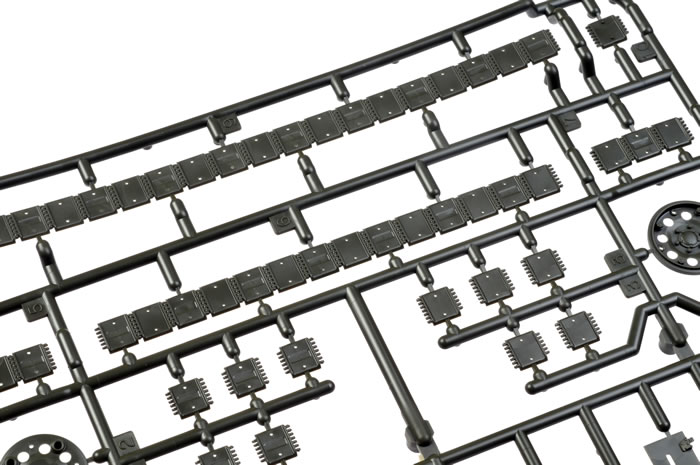
Unlike the hapless EE BT-7 front suspension this kit comes with a very solid and easy to assemble one that solidly supports the leading road wheels.
Accessories are few but it does come with the 40-liter flat fuel tanks that mount on top of the fenders in tracked mode and under them in highway mode. However, while the tracks may be positioned on top of the fenders there are no brackets or straps to attach them in that position.
The turret is nicely done and includes great details such as the proper rim on the outside of the mantlet carrier (part C8). The barrel is in two parts but has a slide molded muzzle and from all appearances will not need an aluminum barrel unless you really want one. There is a basic gun breech as well as two basic seats in the turret but that is it for interior. There is a driver’s seat and interior to his front hatch as well. (Note that Zvezda makes a set of figures which are proper for this tank with pre-war rank insignia and will fit nicely with this kit).
Clear styrene parts are provided for the headlight lenses and driver’s viewer.
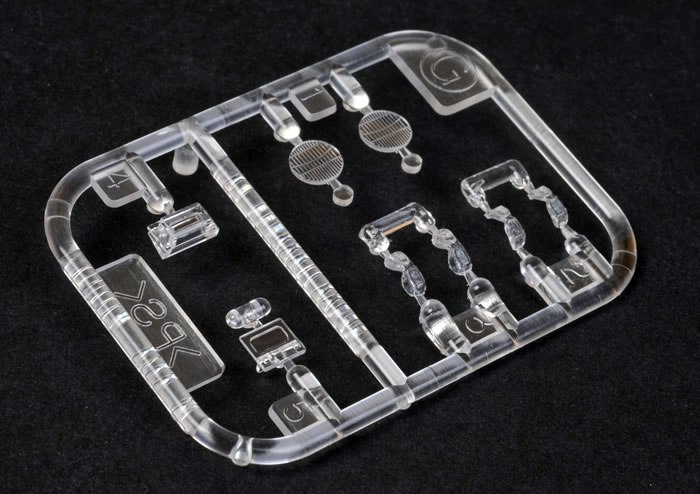
The etched nickel covers the grilles over the radiator air intakes on each side of the engine deck as well as the air exhaust at the rear of the hull.
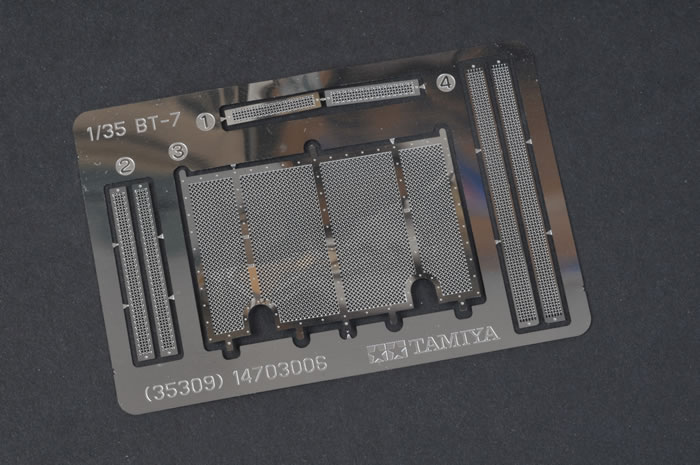
Speaking of figures, Tamiya includes two figures with the kit, a tank commander in enlisted coveralls (officers got leather) and an officer in standard dress. Both are kneeling over a map and appear to be of better quality than many other Tamiya figures (still their one great weakness with kits).
Five different finishing options are offered, all in Soviet 4BO green camouflage (which Tamiya notes may be replicated with their paints by a 50/50 XF4/XF58 mixture). These are: Unknown Unit, Lithuania, Summer 1941 (white recognition cross on turret); Unknown Unit, Moscow Military District, 1936 (white leader’s stripe around turret top edge); Unknown Unit, Ukraine 1941 (small white lines on turret top edge); 6th Tank Brigade, Khalkin Gol, Mongolia 1939 (command stripes on turret and white ID stripes); 4th German Police Division, Pskov Oblast, Russia 1942 (crosses on turret sides). The decal sheet also includes prewar rank insignia for the figures as well, a nice touch.
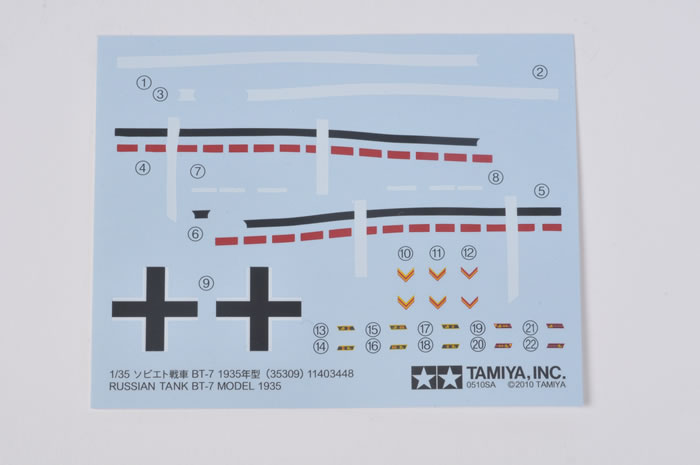
Overall this is one of the best Tamiya kits I’ve seen in years and while very pricey for a small vehicle it is a fairly complete package. I don’t hold it against them that they didn’t do the Model 1937. Yet.
Sprue Layout:
A 57x2 Wheels, suspension, detail componets
B 14 Hull sides, engine hatch
B 21 Hull belly pan, fenders, grille press
C 28 Hull top, turret, antenna, gun and mount
G 8 Clear styrene
P 18x2 BT-5 style track and drivers
Z 17 Two figures and kit
– 7 Etched nickel
– 10 Larger vinyl keepers (black)
– 8 Small vinyl keepers (gray)
– 1 Length of steel chain

















